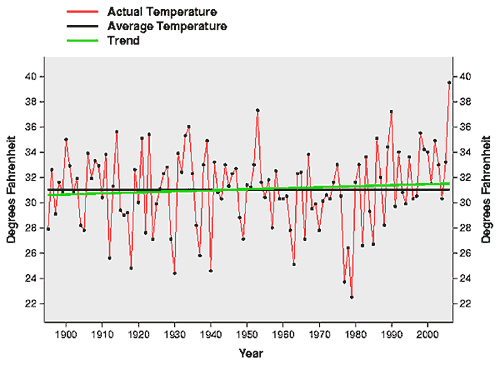
==========================================
Contents:
4) Milkweeds for Monarch Waystations and Rain Gardens
5) Monarch Waystation Seed Kits for California
==========================================
Unless otherwise noted, all content was authored by Chip Taylor, edited by Jim Lovett and Sarah Schmidt, and published by Jim Lovett.
==========================================
Monarch Numbers at the Overwintering Sites in Mexico
The numbers are in. I recently received an excellent report summarizing the census of the number and size of the monarch colonies at the overwintering sites in Mexico for the winter of 2005-2006. This report was authored by Eduardo Rendon and the staff of the World Wildlife Fund Mexico. The grand total for the area occupied by monarchs for the winter of 2005-2006 is 5.92 hectares scattered over 12 colonies. The butterflies appear to be more evenly scattered over the colonies this winter than in most years. It is usually the case that the monarch colonies at El Rosario/El Campanario and Sierra Chincua constitute over 70% of the overwintering population. This year the proportion for these two sites combined was only 34%. Since there continues to be some movement of the butterflies in the first two weeks of the month, including some consolidation of the colonies, areas occupied by monarchs are measured twice in December. The hectares measured for each colony in the last two weeks of the month are used to make the official counts.
The long-term average for the area occupied by the overwintering butterflies is close to 9 hectares. However, because of the year-to-year variance in these numbers, it is probably wiser to consider populations of 7-9 hectares to be “normal” or average. Given that the overwintering population last winter was the all time low, a mere 2.19 hectares, the population this winter represents a substantial (270%) increase over that of 2004-2005.
The reasons for this increase lie in the conditions experienced by the returning monarchs last spring and the consistently warm temperatures throughout the breeding season. To see how the warm summer weather favored the number of monarch generations throughout the summer at several latitudes, please see the Update for September 2005.
I wish to thank Carlos Galindo-Leal for forwarding the WWFMexico report, available in PDF format from www.wwf.org.mx/wwfmex/publicaciones.php?tipo=reps
Rendón Salinas, E., A. Valera Bermejo, M. Cruz Piña, S. Rodríguez Mejía y C. Galindo-Leal. 2006. Monitoreo de las Colonias de Hibernación de Mariposa Monarca: Superficie Forestal de Ocupacón en Diciembre de 2005. Reporte. 5pp
The Northward Migration
As I write this on the afternoon of the 26th of February, the temperature in Angangueo near the overwintering monarch colonies is 64F. The 10-day forecast for Angangueo is for temperatures in the low 70s – typical for this time of year. The weather conditions at the colony sites have been normal this winter and as the end of the overwintering season approaches, it seems likely that the monarchs will get through the winter without any storm related mortality. This is good news. On the down side, the winter has been a bit on the warm side. Higher temperatures at the overwintering sites result in higher activity by the butterflies, increased metabolic rates, greater demands for water, and depletion of stored fat needed by the butterflies to sustain flights and reproduction as the population moves northward. The conditions the monarchs encounter as they move northward could also be an important factor. I will have more to say on this point at a later date.
As I mentioned last month, monarchs begin to mate in the middle of February. Shortly thereafter, probably beginning toward the end of the third week of February, the monarchs begin a slow exodus from the overwintering sites peaking in the middle of March. What appear to be returning migrant monarchs are usually reported from Texas at the end of the first week of March and it is common for numerous monarchs to reach the Austin area at the end of the 2nd week of March. Our knowledge of the time course and pathways taken by the returning monarchs is remarkably poor. We made a few observations of one pathway last year. These sightings were summarized under the subtitle of “Pathways” in the March Update for 2005.
Suspicions Confirmed
When I wrote the Update late last month, I was reasonably confident that the mean temperatures for the month of January were going to be the highest recorded for the continental United States since records have been kept (1895). This was indeed the case. To see this record, visit lwf.ncdc.noaa.gov/oa/climate/research/cag3/cag3.html (U.S. Climate at a Glance). The record for entire nation for the period from 1895-2006 is shown below. You can also obtain data for regions, states and major cities.
You can see from this chart that the long-term mean is about 31F, yet this past January the mean was just short of 40F. No matter how you look at it, the deviation from normal temperatures last month was extraordinary. February started out as a warm month as well but a dip in the jet stream brought colder, and more normal, weather to much of the country. As we approach the end of February, it is warming up again and in much of the central portion of the country March will enter as a lamb with record high temperatures forecast in many areas, e.g., 79F for eastern Kansas on 1 March (mean highs are 46-47F for this date). The warm dry winter could well be part of a La Nina weather pattern (www.pmel.noaa.gov/tao/elnino/la-nina-story.html). Arizona has experienced the worst fall/winter drought on record and drought conditions are becoming more severe from Arizona to Arkansas and northward through Kansas and Nebraska with areas of severe drought also recorded for Iowa and Illinois (www.drought.unl.edu/dm/monitor.html). Of some concern is the pattern of drought from south Texas through eastern Oklahoma and Arkansas. The main path taken by returning monarchs extends through this region and at present the drought is ranked as extreme or exceptional for this entire area.
If you have been following these Updates, you are certainly aware that I’ve become increasingly obsessed with the weather. There is a reason for this preoccupation. Quite simply, monarch populations are largely driven by temperature and moisture. Yes, all those other things like parasites, predators, etc., are important but on a continental basis the principal driver that determines population numbers is the weather.
==========================================
2) Western Monarchs - by Mia Monroe
ROMANTIC END TO WESTERN MONARCH OVERWINTERING SEASON!
Early warm spring days rouse monarchs to fly, flutter and mate causing much excitement among those viewing the last monarchs at Ardenwood, Pacific Grove, Lighthouse Fields, Ellwood and Pismo Beach. With just a few hundred to a thousand monarchs at each site, the public tour season ended at most sites last weekend and with fanfare in Santa Cruz' Migration Festival.
More recent good news could also be found in Santa Cruz with the announcement of plans to protect and enhance the Moran Lake site. Although not nearly as well known as nearby Natural Bridges or Lighthouse Fields, it will now be a focus for the County. The goals are to not only to protect monarchs but also to develop a plan compatible with neighboring property interests and to test inter-planting native trees for buffering or possible roost sites.
An informal evaluation of the 2005-6 season indicates a low year for monarchs with about 10% the number at coastal California sites from what was commonly observed in the early 1990s. And, although, most of those monarchs were either at the Central California sites from Santa Cruz to Santa Barbara (including Pacific Grove and Pismo) there was a surprisingly strong and persistent population in the East Bay sites as well.
==========================================
In the text on white monarchs in last month's Update I commented on the blue monarchs used in advertising. My point was that such monarchs only existed in ads and not in the wild. Unfortunately I was unable to identify where I had seen such images, but they have been common enough so that people have become convinced that such creatures exist.
Here's a nice blue monarch image posted by Flickr member "amuse":
Jim assures me that the image was digitally modified but he didn't want to demystify this particular monarch by reverting the image to it's original state; rather, he took the liberty of creating some technicolor monarchs of his own:

However, it turns out that there are also REAL Blue Monarchs - not the Danaus plexippus monarchs we are familiar with, but Tirumala petiverana of southern Africa where it is known as the African Blue Tiger or Blue Monarch. [Adding to the confusion is the fact that this species is sometimes identified as Danaus limniace petiverana. However, Ackery and Vane-Wright (1984) consider it to be a member of the largely Asian genus Tirumala.] The best image I’ve seen of this species can be found is this one:
www.amanibutterflyproject.org/petiverana.jpg
The blue coloration in these butterflies is faint and apparently non-reflective. Since blue pigments are rare it would be interesting to learn of the basis for the blue color on the wings of these butterflies.
I wish to thank Nigel Venters and Mary Welch-Keesey for drawing my attention to these pale blue monarch relatives.
Reference
Ackery, P. R. and R. I. Vane-Wright 1984. Milkweed Butterflies. Cornell University Press, Ithaca, NY. pp 425.
==========================================
4) Milkweeds for Monarch Waystations and Rain Gardens
If you have been following Monarch Watch, you know all about our Monarch Waystation Program. You may also know that we are trying to persuade those engaged in planting rain gardens to incorporate milkweeds and nectar plants into these gardens. The following text was written to describe the milkweeds that could be productively used in rain gardens in the lower Midwest.
Rain gardens can be ideal habitats for monarchs if they incorporate the host plants needed for monarch larvae and the nectar bearing flowers for the adults. In this short entry, I will describe 6 milkweed species that serve as hosts for monarch caterpillars. All are native to this portion of the Midwest and are suitable for rain gardens. In addition, each is known to have colorful flowers that attract numerous butterflies and other pollinators.
Milkweeds can be started from seeds or can be planted as plugs. The latter is preferable as the plants will get a better start but starting plants from seeds or growing young plants indoors and planting the seedlings can be quite rewarding. General texts describing milkweeds and their propagation can be found at:
www.MonarchWatch.org/milkweed/
[The above referenced propagation text describes stratification as a necessary condition for germination of seeds of most milkweed species; however, germination can also be induced by soaking seeds in hot water. To do this, place seeds in a jar, add hot water, let them sit for a day and then drain off the water and add more hot water each day for the next two days. On the fourth day place the seeds in flats with potting soil - making sure to cover the seeds with 1/4 to 1/2 inch of the soil.]
The milkweed species are arranged below on the basis for their tolerance of wet conditions or need for well-drained soils. The first species, Swamp Milkweed, is tolerant of wet conditions while at the bottom of the list, Butterfly Weed, requires well-drained soils. If I were to plant these species in the typical rain garden, I’d plant the Swamp Milkweeds in the center followed by each of the other species as I moved upslope with the Butterfly Weeds planted around the outer edge of the rain garden.
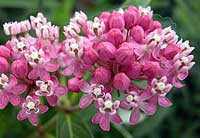 |
Swamp Milkweed – Asclepias incarnata Perennial; Height: 4 to 5 feet. Does well in wet areas. Flowers are bright pink and rarely white. Good nectar plant for butterflies. Lives 3-5 years. Will self sow in wet habitats. |
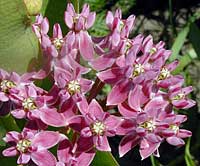 |
Sullivant’s Milkweed – Asclepias sullivantii Perennial; Height: 3 to 4 feet. Flower clusters are erect rather than nodding and vary in color from mixed white to pinkish to a deep purple. Blooms June -July. Good nectar plant for butterflies. Forms clones but not aggressive. Tolerates periodic flooding. |
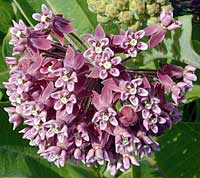 |
Common Milkweed – Asclepias syriaca Perennial; Height: 3 to 5 feet. Flower clusters are greenish purple to dull purple with a pleasant fragrance. Blooms June to August. An excellent nectar plant for butterflies. Forms small clones. |
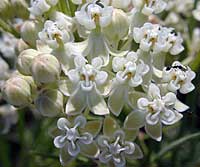 |
Whorled Milkweed - Asclepias verticillata Perennial; Height: 1-2.5 feet. Flower clusters are greenish white to white. Leaves narrow and grass-like and whorled about the stem. Inconspicuous until it blooms. Blooms June to August. Attracts numerous butterflies and other pollinators. Forms small clones. Will grow in a wide range of soil and moisture conditions. |
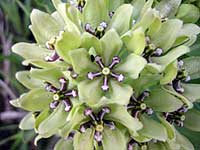 |
Green Milkweed or Green Antelope Horn Milkweed - Asclepias viridis Perennial; Height: 1 to 2 feet. Commonly found in prairies and pastures with clusters of greenish to purplish flowers. Nectar source for early season bumble-bee queens. Drought-tolerant. Blooms from mid May to June and declines in July and August. Needs relatively well-drained soils. |
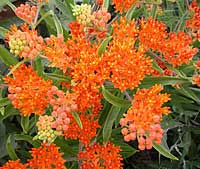 |
Butterfly Weed – Asclepias tuberosa Perennial; Height: 1 to 2 feet. Attractive prairie plant with clusters of brilliant orange flowers. Extremely attractive to butterflies. This drought-tolerant species blooms from June to September. Needs well-drained soils. |
Mark your calendars! Milkweed plugs and seedlings, at least 6 species, will be available at our plant fundraiser and open house at Foley Hall on the 13th of May. Will have more information on this event in the next two Updates.
==========================================
5) Monarch Waystation Seed Kits for California
Some of the milkweeds in our standard Monarch Waystation Seed Kit are not native to California, we decided to create a seed kit especially for those Californians who would like to establish Monarch Waystations. In addition to the basic nectar plants, we have incorporated Asclepias eriocarpa and Asclepias erosa, both native California milkweed species, into a limited number of kits - only to be sent to addresses in California. The demand for these kits could be quite high so order early to reserve your kit:
www.MonarchWatch.org/ws/seed_kit.html
==========================================
The Monarch Waystation idea continues to catch on in unexpected places, showing both the reach of our program and the resonance of the idea of creating habitats for monarchs and other wildlife. On the last day of January we welcomed the Grand Bahama Butterfly Preserve as Monarch Waystation #423 and on the first day of February Jill Fisher, Rudy McCormick and Brian Fisher registered their site in Christiansted (U.S. Virgin Islands) as Monarch Waystation #424.
Thanks to all of you who have continued to register your Monarch Waystations through the winter months. The total number of registered and certified Monarch Waystations now exceeds 460 and we know that there are many more that have been created since we started this program 10 months ago.
The up-to-date Monarch Waystation Registry is available online.
To further the Monarch Waystation program we placed the following ad in the March/April 2006 issue of Bird Watchers Digest
and several articles will appear in gardening and other magazines on the Monarch Waystation program in the coming months. Please help us spread the word. We are hoping that our partnership with the 10,000 Rain Gardens project underway in the greater Kansas City area will lead to the creation of a substantial number of monarch habitats in that area. It’s appropriate that an adult monarch is featured on their web site and that the brochure promoting the rain gardens features a fifth instar monarch larva feeding on milkweed.
We would love to have schools, girl scouts, boy scouts, 4-H participants and others become engaged in the creation of Monarch Waystations. It would be a great project for such groups. The Wolf Cubs of Pack 412 (Smithville, MO) recently sent us a copy of their small grant application to create a Monarch Waystation. The project is designed to engage students in science by creating a resource that can be used to attract monarchs. Some of the monarchs will be reared and others will be tagged. By creating the garden the scouts will gain valuable lessons in the conservation of habitats and will earn a conservation badge. The justification for the project was adopted from the Monarch Waystation materials on our web site. Parents of one of the scouts have provided land for the site. A local farmer has volunteered to till the plot - about 15,000 square feet - and surrounding neighbors have offered their assistance. About 20 scouts will assist with the planting and care of the Monarch Waystation. The project will be used as a demonstration site for other scouts and the community.
Projects such as this can be used as prototypes for the creation of additional Monarch Waystations. We wish the Wolf Cubs luck and encourage everyone to get involved with creating Monarch Waystations - then spread the word!
==========================================
I am headed for Mexico soon and will have more news about the tags recovered in the next Update. There have been only a few reports from the overwintering sites this winter and not much news about the number of tags being recovered. However, on a recent trip Lincoln Brower bought 25 tags on our behalf. The provisional data on these tags is provided below.
You'll notice that some of the tag records are incomplete due to missing datasheets - please let this serve as a reminder: if you have not yet sent us your datasheets please do so as soon as possible; it's not too late! ;-)
| Tag Code | Tagger Name | Tag Location | Tag Date | Reporter Name | Report Location | Report Date |
| EAW494 | Mandi Moore | Drakesville, IA | 9/27/04 | Vicente Moreno | El Capulin | 2/7/06 |
| ECN598 | William Main | Saylor Twp, IA | 9/16/04 | Vicente Moreno | El Capulin | 2/7/06 |
| ECR274 | Assigned to Catherine Irving; Dysart, IA | ? | ? | Vicente Moreno | El Capulin | 2/7/06 |
| EHL865 | Lisa Tite | Chaska, MN | 9/7/04 | Vicente Moreno | El Capulin | 2/7/06 |
| EHR164 | Jan Borland | Arlington, TX | 10/6/04 | Vicente Moreno | El Capulin | 2/7/06 |
| GBB193 | Assigned to Barbara Hagenson; Clinton, IA | ? | ? | Lidio Moreno de Jesus | El Capulin | 2/7/06 |
| GBJ824 | Karen Fulk | Hesston, KS | 9/17/05 | Lidio Moreno de Jesus | El Capulin | 2/7/06 |
| GBZ977 | Cynthia Parker | Conover, NC | 9/23/05 | Lidio Moreno de Jesus | El Capulin | 2/7/06 |
| GCB708 | Tom Kashmer | Fremont, OH | 9/11/05 | Melquiades Moreno de Jesus | El Capulin | 2/7/06 |
| GCC942 | Sarah Bogdinski & Robin Walker | Sharon Center, OH | 9/17/05 | Vicente Moreno | El Capulin | 2/7/06 |
| GCL216 | Sandy Persons | Rodney, MI | 9/3/05 | Lidio Moreno de Jesus | El Capulin | 2/7/06 |
| GCP622 | Assigned to Ann Bolinger; Rockwell, IA | ? | ? | Vicente Moreno | El Capulin | 2/7/06 |
| GCT807 | Bradley Friedhof | Oxford, IA | 9/10/05 | Melquiades Moreno de Jesus | El Capulin | 2/7/06 |
| GCU207 | Lee Co. Conservation Bd. | Keokuk, IA | 9/24/05 | Lidio Moreno de Jesus | El Capulin | 2/7/06 |
| GEE843 | Jo Epping | Ellisville, MO | 9/11/05 | Melquiades Moreno de Jesus | El Capulin | 2/7/06 |
| GGJ866 | Ron Brancato | Henrietta, NY | 9/18/05 | Vicente Moreno | El Capulin | 2/7/06 |
| GHH301 | Tom Murphy | Cannon Falls, MN | 8/24/05 | Melquiades Moreno de Jesus | El Capulin | 2/7/06 |
| GHS116 | Roger Sheve | Sioux Falls, SD | 8/29/05 | Melquiades Moreno de Jesus | El Capulin | 2/7/06 |
| GJB842 | Assigned to Lime Creek Nature Center; Mason City, IA | ? | ? | Diane Pansky | Cerro Pelon | 2/1/06 |
| GJH323 | Nancy Hackbart | Adel, IA | 9/7/05 | Lidio Moreno de Jesus | El Capulin | 2/7/06 |
| GJM458 | St. James Episcopal School | Del Rio, TX | 10/11/05 | Melquiades Moreno de Jesus | El Capulin | 2/7/06 |
| GJX792 | Assigned to Marie Adkins; McKenny, TX | ? | ? | Lidio Moreno de Jesus | El Capulin | 2/7/06 |
| GLG101 | Assigned to Warren Frey; East Berlin, PA | ? | ? | Melquiades Moreno de Jesus | El Capulin | 2/7/06 |
| GLU796 | Kimberly James | Zanesville, OH | 9/11/05 | Lidio Moreno de Jesus | El Capulin | 2/7/06 |
| GMX302 | Bear Branch Nature Center | Westminster, MD | 9/17/05 | Lidio Moreno de Jesus | El Capulin | 2/7/06 |
==========================================
Monarch Watch is a not-for-profit educational outreach program based at the University of Kansas. We manage several educational, conservation and research programs - focusing on the monarch butterfly, its habitat and the spectacular fall monarch migration.
Previous updates are available online at
If you have any questions about this email or any of our programs please feel free to contact us anytime.
Thank you for your continued interest and support!
Monarch Watch
www.MonarchWatch.org
monarch@ku.edu
All material on this site © Monarch Watch unless otherwise noted. Terms of use.
Monarch Watch (888) TAGGING - or - (785) 864-4441
monarch@ku.edu